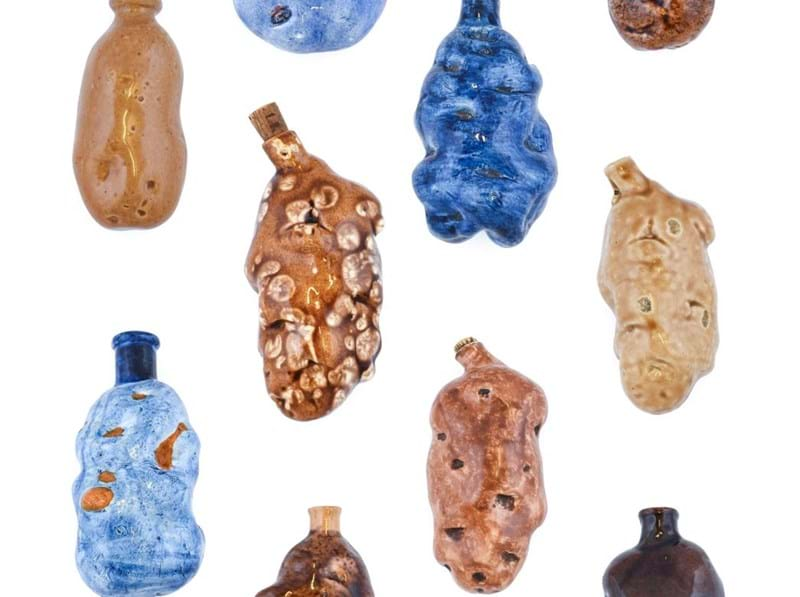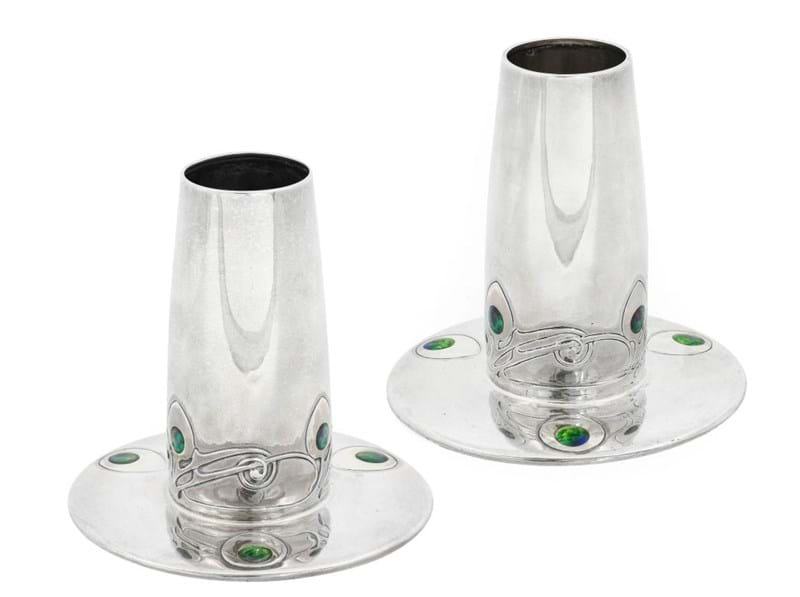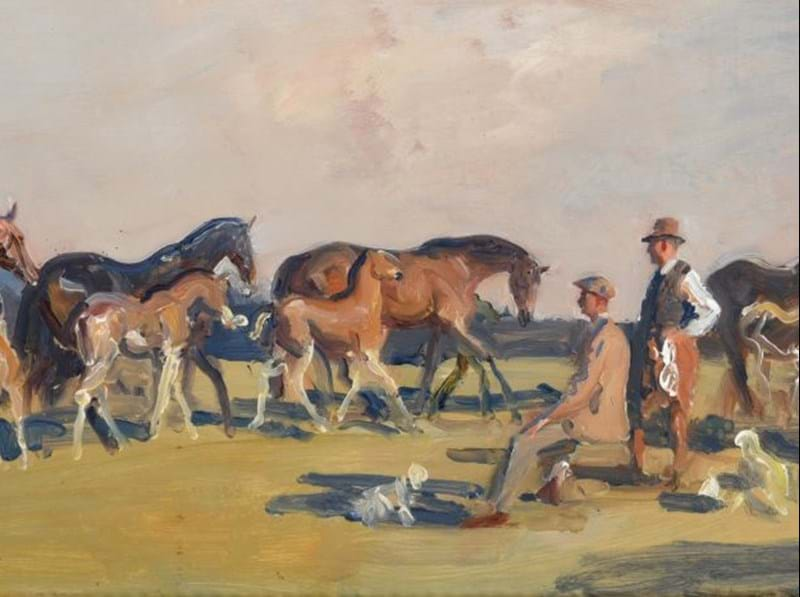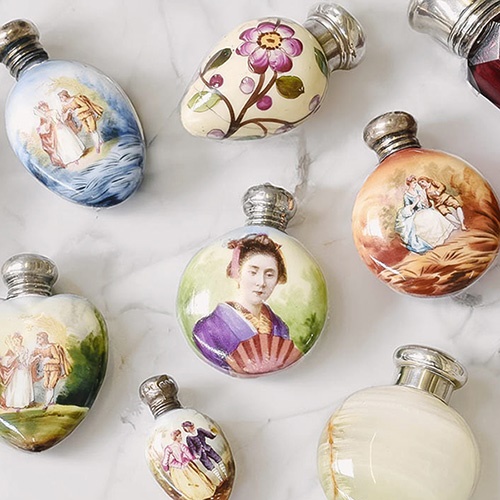From King Richard II leaving a gold ring to each of his executors and William Shakespeare bequeathing rings to a group of friends and actors, to Samuel Pepys leaving 123 ring bequests in his will, mourning jewellery is a solemn but fascinating area of jewellery for the historian and collector alike.
There was something of an obsession with death in the 16th and 17th centuries, and memento mori jewellery grew in popularity. Intended to promote strong morals and virtuous living, stark illustrations of death’s heads, skeletons or coffins made the purpose of these tokens abundantly clear. In this era, memento mori jewels were most often rings, but sometimes made into slides designed to be threaded on a ribbon and worn on the wrist or at the neck or found as part of a chatelaine or even as shoe buckles. Seldom do we see pieces from the 16th or 17th century at auction, but occasionally an item will arise.

A Stuart Mourning Ring, depicting a portrait of King Charles I. The growth of popularity in mourning jewellery is generally attributed to the execution of King Charles I in 1649. This event led to his royalist followers wearing jewellery in his memory. (Sold for £2,400)
From around 1650 mourning jewellery commemorating a particular individual became more commonplace; less graphic imagery was used, and it was more likely to contain woven or plaited hair from the deceased perhaps with twisted gold wire work initials and tiny pearls applied. This might be framed by a row of pearls or other gemstones, and a faceted panel of rock crystal from the South West would be used as protective cover.

A Queen Anne Mourning Ring, depicting a skull and crossbones motif overlaying hair (Sold for £2,100)
From the mid-1700s, the imagery used in mourning items became more sentimental. Corpses and skeletons were replaced with softer subjects like weeping willows, broken columns, winged hourglasses, crossed shovels and picks and urns. At this date, too, mourning jewellery often included some of the deceased’s hair, either plaited as previously mentioned or formed into a bracelet or the bezel of a ring. However, it was sometimes introduced in a less obtrusive manner, by mixing small quantities of cut hair in sepia, which was used to paint a scene on ivory. Strands of hair could also be arranged into a Tree of Life, but by the late 18th century depictions of trees were more commonly a weeping willow.

An Enamel Mourning Ring depicting the Tree of Life, to a shank enamelled in white to read John Wilson OB: 8 March 1764 AE: 29, Wilson Suffered At PAT: EI: Oct 6 1763 AET 35 (Estimate: £100-150 plus buyer’s premium, to be sold in the Jewellery, Watches & Silver Sale on 18th May).
Sometimes a motto would be used on the jewellery which often gave a nod to the afterlife – expressions suggesting a temporary parting, until the deceased and the recipient would meet again, for example. The name age and date of death of the person was usually depicted and most mourning jewellery items seen on the market today use black enamel. However, it was customary to use white enamel in the case of children or the unmarried.


An 18 Carat Gold Enamel Mourning Ring and An Enamel Mourning Brooch the outer shank enamelled in black to read IN MEMORY OF, spaced by panels depicting floral scenes, the inner shank engraved Adam Dugdale Ob April 8th 1838 at 67, the rectangular brooch with a locket compartment centrally, in a black enamel surround reading IN MEMORY OF, the reverse engraved Thos Sidebottom Obt 4th Jan'y 1827 aet 42. Provenance: Dutton Manor, Lancashire (Estimate: £200-300 plus buyer’s premium, to be sold in the Jewellery, Watches & Silver Sale on 18th May).
It was the norm for the deceased’s estate to pay for the mourning tokens, and a person’s will might list the recipients and dictate the type of jewellery and the style to be used. Rings were most common, as can be supported by the quantity that arise in the secondary market today, but lockets and bracelets were not rare.
By the mid-19th century mourning was a large part of life. During the reign of Queen Victoria it was the custom for a widow to wear full mourning – black crepe usually - for one year and one day following the death of her spouse. Nine months of half mourning then followed, where slightly softer fabric was permissible, and a little more decoration to the outfit. It was also required that court went into mourning frequently, to commemorate the deaths of high ranking persons. The versatility of the organic material jet, with its ability to be carved quite intricately and polished to a high shine, or with a more matt finish, made it acceptable for use in mourning. It is such a light material that large objects could be comfortably worn, which suited the voluminous skirts and blouse sleeves of the day. Interestingly, paintings exist that show the use of jet necklaces worn in the traditional way or suspended as loops from a brooch at the neck.

A Jet Mourning Pendant on Fabric Necklace (Sold for £90)
Lockets were tremendously popular by the late 19th century, used to commemorate an occasion such as a wedding, or a love or bond. Unsurprising, then, that they were also popular as mourning tokens, when crafted from onyx or jet, or enamelled.

An 18 Carat Gold Enamel Mourning Ring, the yellow broad band enamelled in black to read IN MEMORY OF, engraved to the inside Adam Dugdale died 8 april 1838 aged 67, Provenance: Dutton Manor, Lancashire (Estimate: £200-300 plus buyer’s premium, to be sold in the Jewellery, Watches & Silver Sale on 18th May)
The topic is vast, but mourning jewellery was prolific at certain times in history. As such, it can easily be studied in museums, and pieces often arise on the second-hand market.











